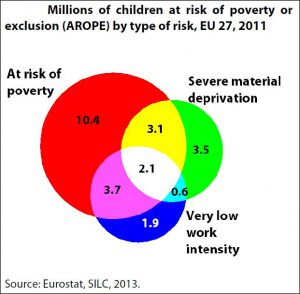According to EU practice, children (defined as people under the age of 18) are considered ‘at risk of poverty and social exclusion’ (AROPE) if they experience one or more of three specific types of poverty: monetary poverty, material deprivation or low work intensity. This AROPE indicator is the broadest measure of child poverty and, applied to the general population, is used as the benchmark for the Europe 2020 headline goal for reducing poverty. The proportion of children at risk of poverty and exclusion (the overall AROPE indicator) ranges widely across EU MS, from around 16% in Sweden, Denmark and Finland to over 40% in Bulgaria, Romania and Latvia.
Children are ‘at risk of poverty’ (ARP) if they are attributed an ‘equivalised’ part of the family income lower than a national poverty threshold, considered to be 60% of the median income after social transfers. This ‘monetary poverty’ measure is a relative measure of poverty since the median income will be different from one MS to another.
According to the EU, children experience ‘severe material deprivation’ (SMD) if they live in households that cannot afford at least four of a list of nine basic items. SMD is an absolute measure of poverty and exclusion since the items are the same for all MS.
Children suffer from ‘very low work intensity’ (LWI) if they live in a household where adults have worked less than 20% of their available work time in the previous year. This condition is most common in households with a single parent and one or more children.








Be the first to write a comment.